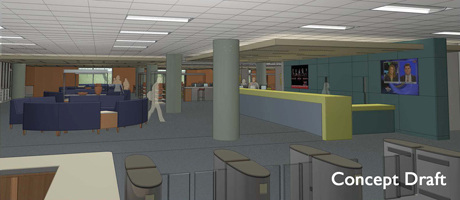A contemporary university library should have extensive space for collaborative learning, lots of spots to plug in laptops, wireless networking and printing capabilities and librarians who specialize in electronic resource use. These are some of the features the GW community suggested for a planned $16 million renovation to the entrance level of the Estelle and Melvin Gelman Library. Now, design renderings offer the first glimpse of how an updated Gelman Library might look.
The concept renderings, created by architecture firm Cox Graae & Spack, show extensive open spaces with clusters of tables and couches, rather than the individual study carrels that now populate Gelman’s entrance level. There are also laptop bars with outlets, as well as more library computers dedicated to accessing electronic resources.
“When Gelman was built in the 1970s, people learned and worked differently,” explained Deborah Gaspar, Gelman’s instruction coordinator. “Now there’s an understanding that learning is a social activity. We need to give students space to exchange ideas and work together.”
The planned Gelman renovation, which was approved as part of the university’s fiscal year 2012 budget, will involve a total overhaul of the entrance level, which students and faculty members have complained is out of date and unwelcoming. “It will give a whole different feel to how the library is integrated into the university,” she said.
In February, GW students participated in a design forum in which they discussed the changes they wanted to see. The new renderings incorporate many of their suggestions, said Jenny Wiley, Gelman’s student liaison.
“I think [the renderings] are stunning,” Ms. Wiley said. “While these preliminary designs will obviously mature as we move forward, they reflect the needs of modern library users. The transformed space will support more refined access to the library’s resources, provide multiple configurations for group and individual study and will also include improved access to technology.”
Ms. Gaspar noted that Gelman has cut its reference collection in half as more and more resources have gone digital, so space previously dedicated to housing volumes and journals can be used for other things. She and other librarians have also discussed how they can better assist students in using digital resources.
“We’ve examined alternative staffing models that would put us there at students’ points of need, instead of behind a big reference desk,” she said.
Design of the space will continue through spring 2012, with construction activities expected to begin in summer 2012. In order to minimize disruption to library activities, construction is expected to take place in multiple phases over the course of three years.
University librarian Jack Siggins said the renovations to Gelman will be “an excellent investment in GW’s future.”
“This new facility will be characterized by engagement, flexibility, collaboration and innovation,” he said. “It will create an environment that will not only promote active learning and creative thinking among students, but will also encourage faculty in innovative uses of technology in teaching. The leadership of GW are to be congratulated on their understanding of the challenges facing the university and their vision of the future of education.”


